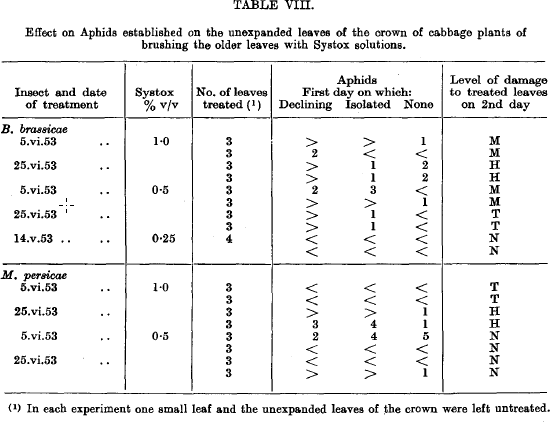Article contents
The Action of the Systemic Insecticide Systox, on Aphids
Published online by Cambridge University Press: 10 July 2009
Extract
The work described in this paper has been carried out with two proprietary samples, designated Systox 50 emulsion and E 1059, of a systemic insecticide of which the active ingredient, subsequently referred to throughout as Systox, is a mixture of O,O-diethyl O-ethylmercaptoethyl thiophosphate and its isomer, O,O-diethyl S-ethylmercaptoethyl thiophosphate.
The samples were tested against Aphids for contact and systemic action.
It is concluded that, as a contact insecticide against Aphis fabae Scop, on broad beans, Systox is about equitoxic with paraoxon and so more toxic than schradan and dimefox.

Systox is readily absorbed by the roots of broad bean and cabbage plants from soil, sand and aqueous solutions and the translocated material is very effective as an insecticide against A. fabae on broad bean, and Myzus persicae (Sulz.) and Brevicoryne brassicae (L.) on cabbage.
Applied in this way, Systox is more effective than schradan, dimefox and paraoxon, and about equal to the most toxic compound previously tested, sodium fluoroacetate.
An experiment by the cut tap-root technique confirms these conclusions. A dose of 1 mg. of Systox per kg. of fresh bean-plant tissue gave a complete kill of A. fabae by the 10th day. The same amount of sodium fluoroacetate had previously been shown to give a complete kill in three days.
The plants were carefully watched for signs of damage during the tests. It was concluded that there was a considerable margin between the insecticidally effective and the phytotoxic concentrations.
Systox is also translocated from older to younger leaves of bean and cabbage plants and it may reach concentrations sufficient to kill the Aphids feeding on the untreated leaves. This effect was more consistently obtained in the broad bean than in cabbage plants. In both cases, however, the results were variable.
Solutions of Systox exert a direct fumigant action on Aphids, but there is little evidence that toxic material is transpired by treated plants.
- Type
- Original Articles
- Information
- Copyright
- Copyright © Cambridge University Press 1954
References
- 6
- Cited by




